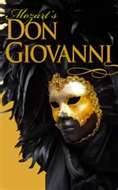
 I have taken the liberty over the past few days to talk about my doves and their progress, though they have nothing to do with the 18th Century (though their name, Chalumeau, is a musical instrument developed from that period), but now I head back to the Enlightened Age!
I have taken the liberty over the past few days to talk about my doves and their progress, though they have nothing to do with the 18th Century (though their name, Chalumeau, is a musical instrument developed from that period), but now I head back to the Enlightened Age!I am scheduled for a trip to the opera very soon - Don Giovanni, to be exact, and I am excited about it!
One of Mozart's greatest works, it premiered on October 29, 1787 at the Teatro di Praga, Prague's great opera house. Lorenzo da Ponte, the famous libretist, worked with Mozart on it, the two of them the Rogers and Hammerstein of their age.
It's dramatic with flashes of comedy, typical of the "opera buffa", with the lead character, Don Giovanni, a young, arrogant, sexually-promiscuous noble finally getting what's coming to him. Finally undone, he is cast, well-deservedly, into the fiery flames of hell!
 Masks are used in the play, typical of the age. The idea of disguise goes far back, associated with the Venetian Carnivale before Lent (carne: meat; val; to leave behind, forego). Originally, the masks were used to heighten the festivities at the masked balls, adding to the mystery and playfulness, flirtation. They were popular until the 18th Century, when one event, in particular, had fatal results.
Masks are used in the play, typical of the age. The idea of disguise goes far back, associated with the Venetian Carnivale before Lent (carne: meat; val; to leave behind, forego). Originally, the masks were used to heighten the festivities at the masked balls, adding to the mystery and playfulness, flirtation. They were popular until the 18th Century, when one event, in particular, had fatal results.Gustav III of Sweden was assassintated at a masquerade ball by a disgruntled nobleman, the event being later documented by Guiseppe Verdi's opera, "A Masked Ball", though the names and places were changed to, as they say, protect the innocent! Are there really any innocents at a masked event! Ah! The anonymity!
The Venetian masks are very specific in their design and theme. There are five in particular that were used. In one of Mozart's letters to his father (March 12, 1783), he explains that at a pantomime he is producing, he will be Harlequin, and his sister-in-law will be Columbine.
The Venetian masks include:
1) The Bauta, which covers the whole face, with a square jaw. The wearer also includes a red or black cape and tricorn hat. This was the dress for a politcal figure, and the wearer obliged to wear the mask when voting to insure freedom and equality in decision-making.
2) The Columbine, a half mask often highly decorated with gold, silver, crystals and feathers. It is held up to the face by a baton or tied with ribbon. It was popularised by an early actress designed for her because she did not wish to have her beautiful face covered completely.

3) The Plague Doctor, with long beak, was adopted for treating plague patients while maintaining distance and sanitation. The eyes had crystal discs set over the holes.
4) The Moretta, strapless mask worn by patrician women, it depicted the mute servant. The wearer bit onto a peg-like wooden piece mounted inside the mask, and therefore could not speak.

5) The Volto, or larva, white, worn with a tricorn. Larva meaning ghost. They could depict a sad face with tears, like the one below.

18th Century culture was much occupied by the concept of the Mask. The shifting or disguising of identity, reveals an interesting aspect of society at the time - ANXIETY, and the ability to put that stress away for a space of time. Wearing the mask also allowed for POSSIBILITY that is not necessarily allowed when a society is fixed where one must conform to fit in.
That's why we all love Halloween, or a costume event where we can try on "someone" else!



No comments:
Post a Comment